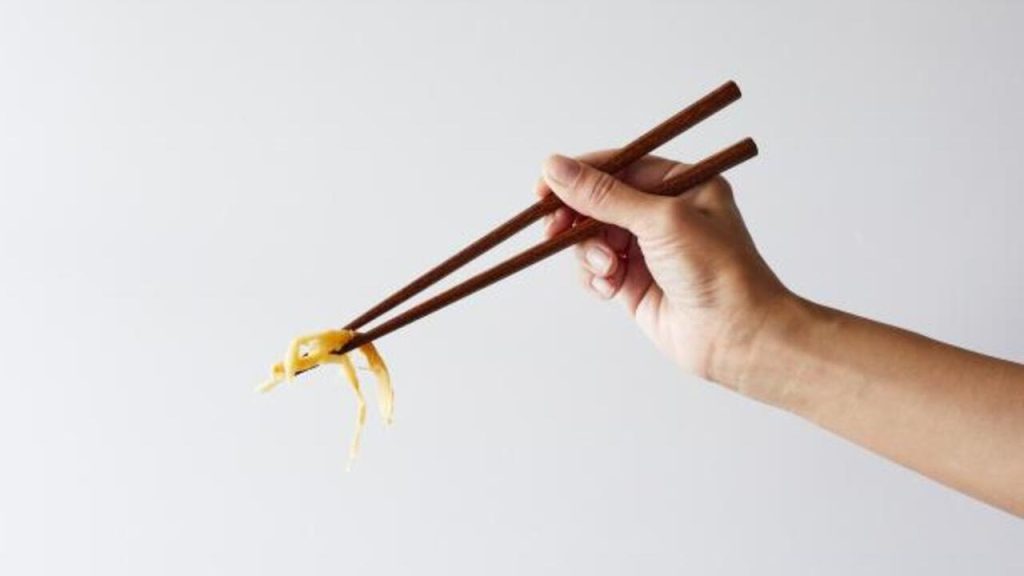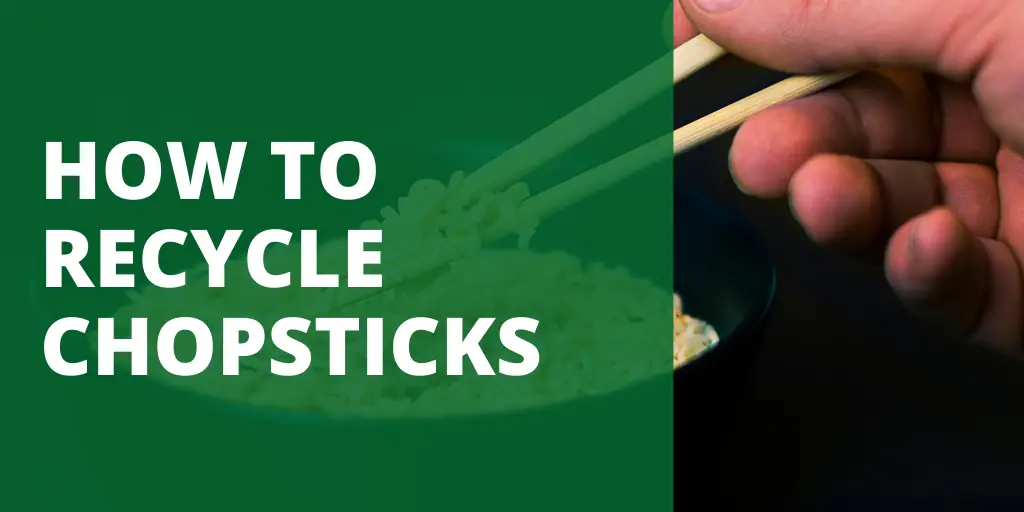Originally stemming from the Chinese and Japanese cultures, chopsticks have become a staple in many American homes, as well as in restaurants. Restaurants often give out chopsticks in addition to plastic cutlery, as a one-time use item.
Unfortunately, these one-time-use chopsticks come with the same issues that plastic cutlery does, in the way that they usually cannot be recycled. This leaves another unnecessary environmental hazard, with us trying to figure out how we can best dispose of these convenient culinary tools.
In this article, we will provide a guide on how to recycle chopsticks and offer some tips on sustainable dining practices.

Why Recycling Chopsticks is Important
Chopsticks are typically made from renewable resources, such as bamboo or wood. However, many chopsticks are also made from disposable materials such as plastic or paper, which are not sustainable and can contribute to environmental problems such as pollution and deforestation.
Recycling chopsticks is an easy way to reduce waste and help protect the environment. Properly recycling chopsticks ensures that these resources are not wasted and can be reused to create new products.
PR Underground explains more on the difficulties that come along with trying to reuse disposable chopsticks:
“In addition, disposable chopsticks are stained with oil or even infectious bacteria, and the washing of wooden chopsticks becomes a big problem. The treatment of washing water is the highlight. Most of the cheap detergents contain phosphorus and other chemical components that are rejected by water.
If they are not treated properly, they can be directly discharged into rivers or infiltrated into the soil, causing pollution of water or soil. It is easy to cause secondary pollution. The meaning of chopsticks recycling is not worth the loss.”
How to Recycle Chopsticks
Here are some steps you can follow to recycle chopsticks properly:
- Clean the chopsticks: Before recycling, make sure to clean the chopsticks thoroughly. You can rinse them with water or wipe them down with a damp cloth to remove any food residue or stains.
- Check the recycling guidelines: Different recycling facilities may have different guidelines for what materials they accept, so it’s essential to check them before recycling your chopsticks. Some facilities may take chopsticks as part of their mixed paper recycling program, while others may require you to separate them from other materials.
- Separate the chopsticks: If the recycling facility requires you to separate the chopsticks from different materials, ensure that. You can tie them together with a rubber band or string to keep them together.
- Place the chopsticks in the recycling bin: Once you have cleaned and separated them, place them in the appropriate recycling bin. If you need help deciding which bin to use, check with your local recycling facility or waste management program.
How to Dispose of Chopsticks
Disposable chopsticks must most often be disposed of in the trash, and cannot be recycled. However, there may be some exceptions to this rule. While most disposable chopsticks are made of wood, some plastic chopsticks may be able to be recycled.
Conserve Energy Future tells us more on how to correctly dispose of chopsticks, depending on their material:
“The majority of chopsticks in use today are either made from plastic or wood. Though there are no specific labels to help recognize which is which, one thing we know is that plastic chopsticks are made from a raw material called polypropylene, and they can be recycled. Often, you will find a recycling sign on the chopstick, which signifies that its disposal should only be in the recycling bin.”
Is There an Alternative to Disposable Chopsticks?
Reusable chopsticks have become much more popular in recent years, and are a great solution to avoiding this environmental dilemma altogether. Reusable chopsticks are often made of stainless steel and can be washed and dried over and over again.
Eric A. Goldstein, New York City environment director and senior attorney at the Natural Resources Defense Council tells HuffPost why you should consider reusable chopsticks:
“It’s easy to keep a reusable pair of chopsticks in a backpack, purse, or desk drawer,” Goldstein said. “Most chopsticks are made in China, tens of billions a year, and are contributing to deforestation there. Reusable wooden or plastic chopsticks make much more sense.”
Sustainable Dining Practices
In addition to recycling chopsticks, there are other sustainable dining practices that you can adopt to help reduce waste and protect the environment. Here are some tips:
- Use reusable chopsticks: Instead of disposable chopsticks, consider investing in reusable chopsticks made from sustainable materials such as bamboo or stainless steel. These can be easily cleaned and reused and can help reduce the amount of waste produced.
- Bring your utensils: When dining out or ordering takeout, consider bringing your utensils instead of using disposable ones. You can keep a set of reusable utensils in your bag or car and use them whenever needed.
- Reduce food waste: To reduce waste, only order what you can eat and take home any leftovers. If you have excess food, consider composting it to help create nutrient-rich soil.
Benefits of Recycling the Chopsticks
Chopsticks are a staple utensil in many Asian cultures, and millions worldwide use them. However, the production and disposal of disposable chopsticks significantly impact the environment. Recently, there has been a growing awareness of the benefits of recycling chopsticks.
1. Reducing Waste
The primary benefit of recycling chopsticks is the reduction of waste. Disposable chopsticks are made from wood, bamboo, or other materials that require a significant amount of resources to produce.
By recycling chopsticks, we can extend the life of these materials and reduce the amount of waste that ends up in landfills.
2. Conserving Resources
Recycling chopsticks also helps to conserve natural resources. As mentioned earlier, disposable chopsticks require a significant amount of resources to produce, including wood, bamboo, and other materials.
Recycling chopsticks can reduce the need for new resources and preserve natural habitats.
3. Reducing Carbon Footprint
Another benefit of recycling chopsticks is the reduction of carbon emissions. The production and transportation of disposable chopsticks contribute to greenhouse gas emissions.
By recycling chopsticks, we can reduce the energy required to produce new chopsticks and decrease the carbon footprint of chopstick production.
4. Creating Jobs
Recycling chopsticks can also create new jobs. Chopstick recycling programs require people to collect, sort, and process used chopsticks. This can create employment opportunities for individuals in local communities and provide them with a steady source of income.
5. Promoting Sustainability
Finally, recycling chopsticks promotes sustainability. By reducing waste, conserving resources, and reducing carbon emissions, chopstick recycling programs help to create a more sustainable future for our planet.
The Bottom Line
Recycling chopsticks is an easy way to reduce waste and help protect the environment. Following these simple steps, you can properly recycle your chopsticks and ensure they are reused to create new products.
Additionally, adopting sustainable dining practices can further reduce waste and help create a more sustainable future.
Can you clean and reuse chopsticks?
Yes, chopsticks can be cleaned and reused multiple times. It is recommended to wash them with soap and warm water and allow them to air dry before using them again.
Alternatively, you can boil them in water for a few minutes to sanitize them.
How wasteful are chopsticks?
Chopsticks are quite wasteful due to their disposable nature. Over 80 billion pairs of disposable chopsticks are produced each year. This leads to deforestation, resource depletion, and waste accumulation in landfills.
Can wooden chopsticks be reusable?
Yes, wooden chopsticks can be reusable if they are properly cleaned and maintained. However, they may not be as durable as metal or bamboo chopsticks and can break more easily.
Additional Posts:


